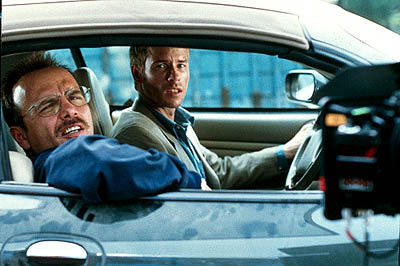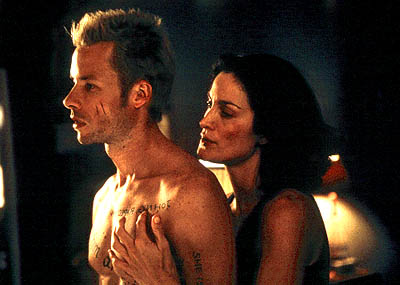|
Memento
|
|
 |
 |
|
There is a dearth of original ideas in today's movies. So what can one do to jazz up a story about a man looking for his wife's killer? How about giving the main character, Leonard Shelby, a medical condition where he has no short-term memory? Not enough? Okay, the have the movie start at the end and move its way back to the beginning. Memento is one of the most original ideas in recent memory, and the resulting film is complex and engrossing. Shelby's (Guy Pearce, Rules of Engagement, Ravenous) condition began after the death of his wife. His condition is so extreme that during a conversation, he can forget who he is talking to, and what he was talking about. Shelby sidesteps his impediment by taking Polaroid photographs. He writes names and notes on them to help him 'remember' the people around him. He also tattooed his body with clues and phrases to help. The movie begins with an eerie shot of a Polaroid undeveloping. It flies back into the camera, Shelby takes the picture, a gun flies up from the floor into Shelby's hand, and the bullet goes back into the cartridge. Now, the audience knows who Shelby believes killed his wife, but does not know why. Writer/director Christopher Nolan (Insomnia, Following), working off a short story by his brother Jonathan Nolan, succeeds in completely disorienting the viewer. Each action is obvious enough, but nobody knows the motivation behind what Shelby does. For this, they must wait until the film moves back to the previous scene. Instead of becoming clearer, the story becomes increasingly complex as the backstory begins emerging. In effect, Nolan gives each person watching a handicap similar to that of Shelby. The people watching don't know what he is doing, and he doesn't either. If any film demands multiple viewings to fully understand, this is certainly it. Even in the same viewing, people must pay careful attention as not to miss any pertinent information. Everything from the car Shelby drives to the clothes he wears has some significance. The two main people currently in his life are Teddy and Natalie. Teddy (Joe Pantoliano, Ready to Rumble, Black and White) is a man who keeps appearing to help Shelby. The back of his picture has the phrase "don't believe his lies." Natalie (Carrie-Anne Moss, Chocolat, Red Planet) is a woman he befriends. She tells him that because he helped her with a situation, she is helping him locate the murderer. Shelby's problem is that he has no idea whom to believe. Each person may have their own agenda and may be using Shelby's condition to their advantage. The performances by Moss and Pantoliano (what, is this a Matrix reunion?) complement their characters. Both are mysterious. Pantoliano has a fake smile and oozes slime, whereas Moss seems to be hiding something in her eyes. Pearce's performance holds Memento together. He convincingly portrays a man trying to do what he think is right. His actions are methodical and practiced, to try to regain a sense of order in his life. Shelby also attempts to recreate events in his life, hoping it will spark his errant memories. Nolan uses telephone conversations to expand on the story and on Shelby's past, which helps to round out his character. Nolan also supplies a surprising amount of humor in the movie. The ending (beginning?) is also completely original. It seems to come out of left field while remaining perfectly in-line with the universe Nolan created. |
|
| Mongoose Rates It: Really Good. | |
| 1 hour, 45 minutes, Rated R for violence, language, and some drug content. | |